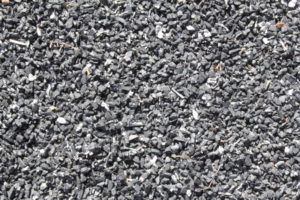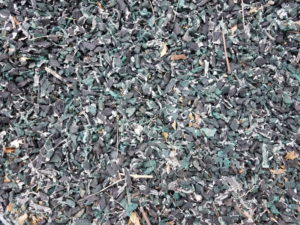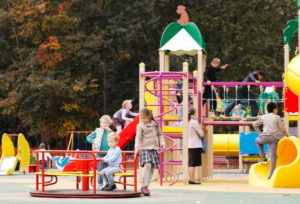Bonded rubber mulch (sometimes called bonded rubber bark or resin bound rubber mulch) looks like traditional wood chips (such as landscaping mulch). But upon closer inspection, you’ll quickly realize that it’s different.
What is bonded rubber mulch? Bonded rubber mulch is an artificial playground surface made of shredded pieces of rubber that are stuck together to form a unitary surface. In other words, this playground surfacing option isn’t loose pieces of rubber mulch or wood mulch. They’re compressed and appear to be “glued” together (which is why it’s sometimes called “resin bound rubber mulch”).
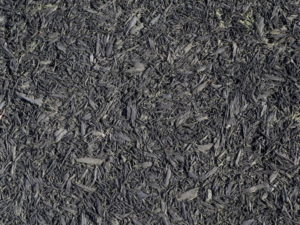
Is Bonded Rubber Mulch the Best Option for Playground Flooring?
Bonded rubber is a popular choice for playgrounds and other recreational surfaces. It provides a comfortable, soft cushion to walk, run, or play on, and complies with ADA standards (PDF) for handicap accessible playgrounds. People who choose this option report the benefits of using it are that it’s easy to customize and the safety of bonded rubber compared to other mulched materials is superior.
But we all know that “popular” doesn’t make something “better.” So, let’s take a closer look at the factors to take into account when you’re considering installing a bonded rubber playground surface.
- Safety of Bonded Rubber Mulch
- Cost of Bonded Rubber Mulch
- Quality of Bonded Rubber Mulch
- Installation of Bonded Rubber Mulch
Safety of Bonded Rubber for Playgrounds
One of the basic and most important considerations for a playground is critical fall height requirements for the surface, which have to do with shock absorbency.
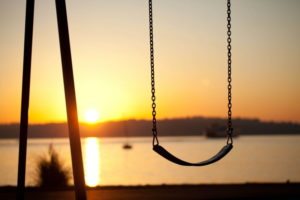
Pros:
- Depending on the exact product used, bonded rubber mulch can require 6 inches of material to better protect a child from a 10-foot fall, according to American Standard Testing Methods (ASTM), the institution tasked by the federal government with setting industry safety standards.
- In terms of both safety and accessibility by those with disabilities, because it’s a unitary surface, bonded rubber is a better playground flooring choice than common loose fill materials (such as shredded rubber mulch, wood chips, sand, engineered wood fiber, pea gravel, or dirt/grass).
- Like poured-in-place rubber or tiled rubber playground flooring, debris (such as litter, sticks, etc) is unlikely to get buried in the material.
Cons:
- Pieces can become loose (think “unglued”).
- Typically only a single layer of surfacing.
TIP: Bonded rubber is surpassed in safety by poured-in-place rubber flooring, which is the most shock absorbent of available playground surfacing materials, in addition to allowing for the most mobility by kids who need physical aids (like wheelchairs, walkers, scooters, etc).
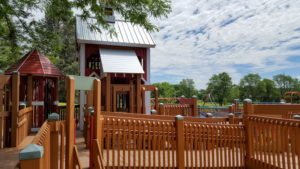
Cost of Bonded Rubber Mulch Playground Surfacing
Pros:
- Depending on fall height requirements (depth of surfacing needed), color choices, the condition of the existing surface, location, and a few other factors, the cost of covering a playground 1,000 sq. ft. or larger with bonded rubber mulch can range from $8 to $16 per sq. ft. installed.
Cons:
- You can expect bonded rubber mulch to last about 10 years before needing to replace it. However, it usually requires intermittent patching up. To ensure the surface continues to meet critical fall height requirements, you may find you need to replace sections of the bound rubber mulch material sooner than what is recommended — especially if the playground is located in an area that does not allow for adequate drainage.
Quality of Bonded Rubber Mulch Playground Flooring

Pros:
- Many manufacturers of bonded rubber mulch guarantee that it is made with safe materials that are free of contaminants and chemicals that could irritate sensitive skin.
- Bonded rubber mulch comes in a variety of colors that make for an aesthetically pleasing playground or recreational area.
Cons:
- It’s not expected to last as long as poured rubber playground surfaces.
- Because the material resembles wood fibers and other natural materials, it cannot accommodate the stenciled games or intricate designs/patterns as you might find in poured rubber playground surfaces.
- Not all installers use premium materials.
TIP: If you choose bonded rubber mulch for your playground, find an installer who uses only premium rubber materials, like EPDM, SBR, and natural materials. You’ll want to know it’s guaranteed to be free of wire, wood, and other contaminants.
Installation of Bonded Rubber Mulch for Playgrounds
Pros:
- Bonded rubber mulch is on the easier-installation end of playground surfacing choices.
- Quick for professionals to install. Depending on the size of the playground, professional installers are typically able to complete it in about one day.
Cons:
- Surface preparation for bonded rubber mulch installers can increase the time (and cost) of the installation.
- Installation isn’t a once-and-done type of thing. Bonded rubber mulch needs maintenance in order to maintain its safety qualities. If you do not maintain the specific installation depth on a playground, children who fall are at risk of serious injury.
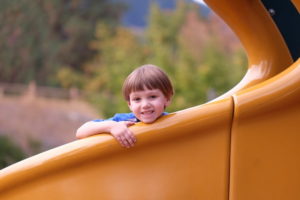
Next Steps
You’ll want to also consider factors such as climate in your area, budget, product availability, and location constraints.
Bonded rubber playground mulch (which we don’t install) isn’t the only rubber playground surfacing option! For larger playgrounds (at schools, parks, daycare centers, and other public playgrounds), we recommend considering a different uniform rubber surface (like poured-in-place rubber or rubber playground tiles). The reason we only install those is because we honestly believe they’re some of the best surfacing options for your playground.
Again, we don’t bonded rubber playground surfacing (because we don’t think it’s the best option for kids or parents). You probably still have questions — contact adventureTURF for answers! We’d love to help you design the safest, most accessible playground surface possible! If you’re ready to take the next steps to choosing the right type of playground surfacing for your situation, reach out to us to request a free quote (for poured rubber or rubber tile playground surfacing). We’d love to help you create a place for adventure!
With so many different qualities and characteristics to consider, choosing a playground surface can be bewildering. That’s why we’ve created an ultimate guide of all the pros and cons of 11 of the most popular playground surfaces, from wood chips to recycled rubber mulch.
FAQ
The cost of covering a playground 1,000 sq. ft. or larger with bonded rubber mulch can range from $8 to $16 per sq. ft. installed.
Bonded rubber mulch can require 6 inches of material to better protect a child from a 10-foot fall, according to American Standard Testing Methods (ASTM). Pieces can often become loose, and typically a single layer of surfacing is used.
Bonded rubber mulch is quick for professionals to install. Depending on the size of the playground, professional installers are typically able to complete it in about one day. However, installation isn’t a once-and-done type of thing. Bonded rubber mulch needs maintenance in order to maintain its safety qualities.
